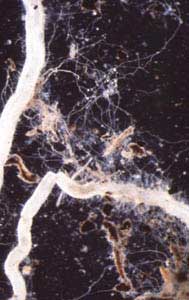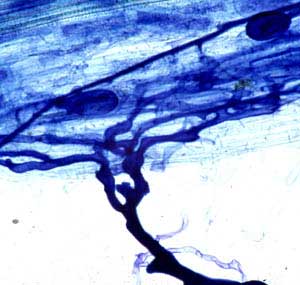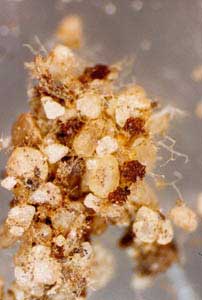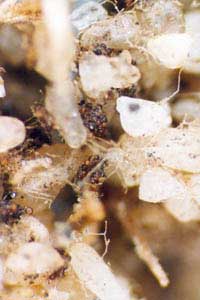Soil Fungi
- What are the four types of mycorrhizal associations and which plants are involved with them?
- What are arbuscular mycorrhizas?
- Can you see arbuscules and vesicles?
- What are the characteristic features of arbuscular mycorrhizal fungi from different genera?
- What are the main structural characteristics of ectomycorrhizal fungi?
- How do ectomycorrhizal fungi affect plants?
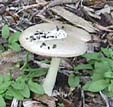
Question 1: What are the four types of mycorrhizal associations and which plants are involved with them?
The four kinds of mycorrhizal fungi are: arbuscular, ectomycorrhizal, ericoid and orchid mycorrhiza. Most agricultural plants, vegetables and orchard plants form arbuscular mycorrhizal associations. Ectomycorrhizal associations are less common in disturbed ecosystems and are more commonly on perennial plants than annuals. Ornamental plants form associations from each of the four groups and orchid mycorrhizal associations are formed only by orchids.
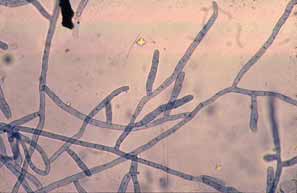
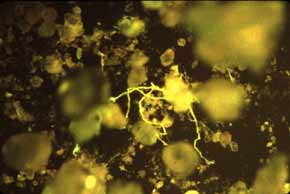
Question 2: What are arbuscular mycorrhizas?
Arbuscular mycorrhizas are roots with specific types of fungi inside them and in the surrounding soil. This type of mycorrhiza is formed by fungi in a group generally referred to as arbuscular mycorrhizal fungi. These fungi are characterised by having very thin threadlike structures, called hyphae, which are between 1 and 10 thousandths of a millimetre in width. (Hyphae is pronounced "high-fee"). The hyphae form networks between neighbouring soil particles, between roots and soil particles, between roots on the same plant, between roots of different plants (even different types of plants) and in the plant roots themselves. The networks of hyphae are also referred to as mycelium.
Arbuscular mycorrhizas are called this because they have developed a specific structure called an "arbuscule". Although some kinds of soil fungi can be associated with plant and animal disease, the fungi that form arbuscular mycorrhizas belong to a group of soil fungi that can be very beneficial. The name "mycorrhiza" means "fungus root" and this is derived from the close association of the fungi with plant roots - in fact, arbuscular mycorrhizal fungi cannot complete their life cycle unless they are connected to plant roots. Generally, it is not possible to grow these fungi without the support of the plant. The reasons for this are still largely unknown.
Mycorrhizas get their carbohydrate (energy) from the plant root they are living in/on and they usually help the plants by transferring phosphorus from the soil into the root.
This means they are important in soils that do not have enough phosphorus (relative to other nutrients) for plant growth. Mycorrhizas are particularly important for phosphate uptake because phosphorus does not move towards plant roots easily. Some nutrients (like nitrogen) are carried wherever the soil water moves, but phosphorus is not like this. Therefore, it is necessary for roots to intercept the phosphorus in the soil before it can be taken up into the plant. What the fungi do is extend the volume of soil that can be explored by the plant for phosphorus. Thus, when phosphorus is scarce, plants that have developed mycorrhizas on their root systems can take up more phosphorus than plants with none or only small amounts of mycorrhizas. Although arbuscular mycorrhizas form on a majority of types of plants, there are some plants that do not form this type of mycorrhiza. Two examples are canola (oilseed rape) and lupin. Arbuscular mycorrhizas are found in natural ecosystems as well as in agricultural areas. They are common on both perennials and annuals. Arbuscular mycorrhizal fungi can also benefit the physical characteristics of the soil, because their hyphae form a mesh to help stabilize soil aggregates.
Arbuscular mycorrhizal fungi may also help to protect plants from root diseases present in the soil, and in some cases may help plants absorb copper and zinc from the soil. These are plant nutrients that behave in a similar way to phosphorus in soil and the plant roots need to explore the soil to intercept them. There are only 5 groups (called genera) of arbuscular mycorrhizal fungi and these are distributed throughout the world. They are known by their Latin names for the genera they belong in as: Acaulospora, Entrophosphora, Gigaspora, Glomus, and Scutelospora.
Question 3: Can you see arbuscules and vesicles?
Arbuscules are formed by mycorrhizal fungi inside a cell within a plant root. They are the places where the plant and the fungus exchange food and nutrients with each other. Carbon and phosphorus and other nutrients may also be exchanged though hyphae that ramify inside the root, but it is likely that the arbuscules are the major site for nutrient exchange. Arbuscules look a bit like minute sea anemones because they have many small projections that extend inside the plant cells. They are formed by repeated branching of a hypha when it enters a cell.
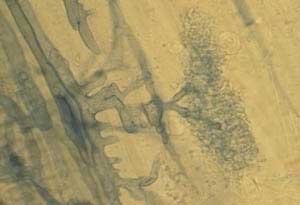
Vesicles are also structures formed inside the plants' roots. They look like an oval bag and most people believe that they are used for storing nutrients. Only three of the five genera of arbuscular mycorrhizas (Glomus, Acaulospora and Entrophosphora) form vesicles.
![]()
Question 4: What are the characteristic features of arbuscular mycorrhizal fungi from different genera?
There are only 5 groups (called genera) of arbuscular mycorrhizal fungi:
- Glomus
- Acaulospora
- Entrophosphora
- Gigaspora
- Scutelospora
The fungi are grouped according to the size, shape and wall structure of their spores. The spores are approximately spherical or ovoid in shape and usually have thick walls so they can survive harsh environmental conditions. When soil conditions are favourable, the spores germinate and hyphae grow out of the spore. These hyphae can then enter roots and set up the mycorrhizal association.
Spores are between 30 and 500 micrometres in size - this is between 30 thousandths of a millimetre and half a millimetre. Identifying and classifying the spores is therefore something that must be done with the aid of microscopes.
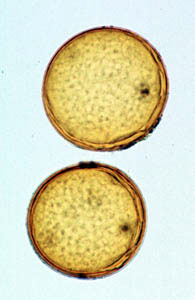
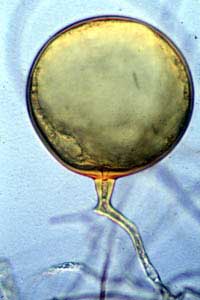
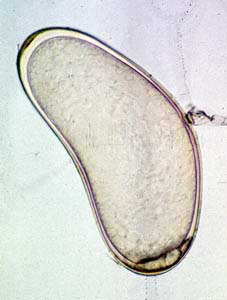
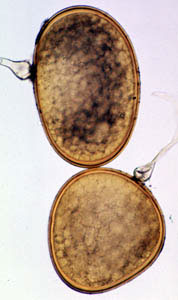
Also, fungi grow differently in roots depending on the type of fungus and the growth habit of the root itself.
.jpg)
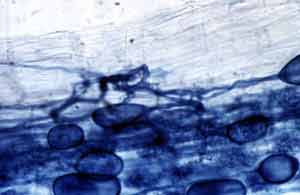
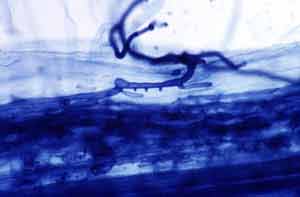
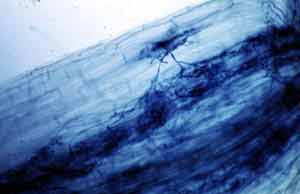
Question 5: What are the main structural characteristics of ectomycorrhizal fungi?
There are three main structural characteristics of ectomycorrhizal fungi.
- Hyphae extend from the root through the soil surrounding the roots.
- The hyphal mat covers the surface of the root to varying degrees.
- The Hartig net is a net of hyphae that exists between the outer (epidermal) cells of roots.
Question 6: How do ectomycorrhizal fungi affect plants?
Ectomycorrhizal fungi also have the potential to positively affect plant growth. Ectomycorrhizal fungi can change the growth form of plant roots by promoting root branching and restricting root extension. Ectomycorrhizal fungi can increase the uptake of phophorus by plant roots and some species of fungi also improve nitrogen uptake. They can decrease the susceptibility of the plant to disease and drought. The hyphal mantle over the surface of the roots can provide protection against the entry of pathogenic soil fungi and the hyphal network in soil surrounding roots allows water uptake from more soil. These effects on plant growth combine to make the associated plant more robust and increase its chances of survival.
Search Site
- Soil Health
- Help/Feedback
- Contact us
- Sitemap


